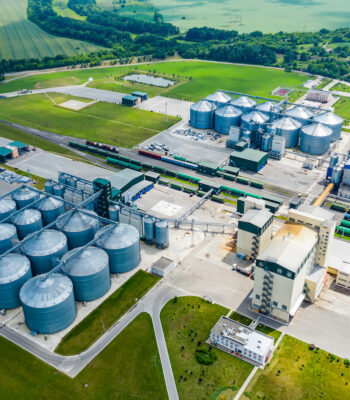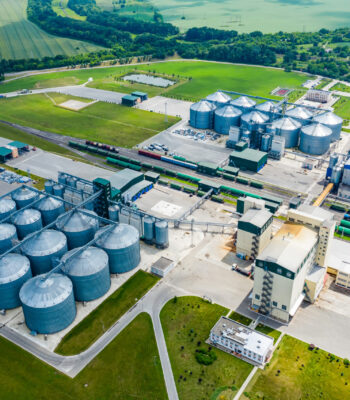Choosing the right carbon management software is now a make-or-break decision for companies facing intense pressure to track and reduce emissions. From regulatory compliance to investor demands, organizations need robust systems that can handle complex data collection, analysis, and reporting requirements. But with dozens of vendors in the market, how do you cut through the noise and pick a solution that actually delivers?
You’ll likely need to kick off a request for proposal (RFP) process. But before you dive into carbon management software evaluations, you need a rock-solid understanding of your requirements—from organizational scope to technical specs. This guide breaks down the key elements to consider as you build your RFP, and then explores the exact questions your carbon management RFP should include.
Key takeaways:
- Don’t start with vendor assessments—start with scope. Map out exactly which entities, facilities, and emission sources you need to track across your organization. This shapes everything from data collection requirements to user access controls and ultimately determines project success.
- Your reporting needs will evolve fast as new regulations take effect. Choose a platform that supports multiple frameworks and can adapt quickly. Pay special attention to how the system handles scope 3 emissions data and supplier engagement, as these requirements are becoming increasingly stringent.
- Implementation, ongoing support, and team expertise matter more than feature lists. Dig into the vendor’s experience with similar organizations, their services model, and their fee structure for support. The best software will be worth much less if it’s too complicated to use.
- Get clear on the costs up-front. The initial quote from a vendor might look good—but will they charge you extra for implementation, or make you hire an expensive consultancy to implement? How about support? Additional fees add up, so ask for clarity from the start.
Want to skip the RFP process and go straight to demoing carbon management solutions? Get in touch and we’ll schedule your Optera demo ASAP.
Define your carbon management project context and business drivers
Before copying and pasting a carbon management RFP template you found online, or drafting something similar to your company’s other RFPs, you need to map out why you’re investing in carbon management software and who needs to be involved. Carbon management RFPs often fall short because they’re written in isolation, without input from key stakeholders like sustainability teams. The result? Redundant questions, misaligned requirements, and ultimately, the wrong solution.
Start with your stakeholder ecosystem
Your carbon management software will touch multiple teams, each with distinct needs:
- Sustainability teams handle day-to-day emissions tracking and target setting
- Finance owns budget and needs to understand ROI
- Procurement manages supplier relationships and data collection
- Marketing translates your progress into external messaging
- Auditors and verifiers need access for validation
- Suppliers must input their emissions data
- IT/security teams ensure platform compatibility and data protection
Get these stakeholders involved early. Their input shapes both your requirements and your timeline.
Know your regulatory landscape
The regulatory environment is evolving fast. Your platform needs to handle current and upcoming requirements. Key regulations to consider:
- California SB 253 and 261 mandate emissions reporting for large companies
- AB1305 sets specific disclosure requirements for climate-related claims
- CBAM requires emissions disclosures for EU imports
- CSRD introduces detailed sustainability reporting standards
Factor in external pressure
Beyond regulations, identify which investors and stakeholders demand emissions data. Are you facing ESG rating pressures? Do customers want product-level carbon footprint data? These demands shape your reporting requirements.
Set clear goals and timelines
Be realistic about your timeline. A successful RFP process takes longer than you think. Plan backward from when you need your first complete emissions inventory, factoring in:
- RFP development and distribution
- Vendor demos and evaluation
- Contract negotiations
- Implementation and training
- Data collection and validation
Your carbon management goals might include:
- Meeting specific emissions reduction targets
- Improving emissions data transparency
- Managing climate-related risks
- Streamlining reporting processes
Bottom line: Don’t rush this phase. A thorough understanding of your business context, stakeholders, and timeline sets the foundation for everything that follows.
Define the scope and technical requirements of your carbon management software
Before writing a single RFP question, you need to be crystal-clear on the requirements for your carbon management software implementation. Miss this step and you’ll waste time evaluating solutions that can’t actually handle your needs. This is one area where the input of your sustainability team is absolutely essential.
Organizational coverage
First, map your company’s carbon footprint structure. You need to know:
- Which entities your system must track—including subsidiaries, facilities, and key suppliers
- Your geographic spread and how much of it needs coverage
- Total number of facilities and locations requiring monitoring
Pro tip: Be ruthlessly specific here. “Global operations” isn’t good enough—break it down by country, site count, and entity type.
Emissions scope coverage
Scope 1 & 2
Start with your direct emissions. You need to understand:
- All direct emission sources (vehicle fleets, manufacturing processes, etc.)
- Types of energy consumption requiring tracking
- Number of utility accounts to manage
Don’t forget: Different regions often mean different utility providers and different regulatory reporting requirements.
Scope 3
Scope 3 emissions are complicated—and not a focus area for every carbon management software vendor. Get clear on:
- Which scope 3 categories actually matter for your business
- Number of suppliers to track
- Calculation methods needed (spend-based, supplier-specific, hybrid)
- Supplier emissions tracking requirements (company, facility, or product level)
Remember: Your emissions tracking will likely expand over time as new regulations enter into force and stakeholder demands increase. When defining your scope, build in flexibility and room for growth, so that whichever solution you choose does not become obsolete as soon as it’s implemented. Your carbon management platform should be able to easily scale to handle increasing volumes of data, new emissions sources, and expanding reporting requirements.
Building your carbon management software RFP
Now comes the heavy lifting: defining your technical and functional requirements. A solid RFP needs to cover everything from data handling to vendor qualifications. Skip any of these sections and you risk choosing a platform that looks great in demos but falls short in real-world use.
Below is a comprehensive checklist—depending on the project context and technical requirements you’ve defined in the steps above, some of these questions might be superfluous. On the other hand, your specific RFP might need to go deeper than what we’ve listed here in certain sections. Ensure that you’ve collected input and feedback from all relevant stakeholders.
Reporting framework alignment
Your carbon management software needs to handle multiple reporting frameworks and adapt as requirements evolve. Here’s what to ask:
- How does your solution ensure compliance with GHG Protocol standards?
- What features support SBTi target setting and tracking?
- How does the platform support PCAF requirements for financial institutions?
- What capabilities exist for ESRS reporting?
- How are framework updates managed and implemented in the system?
Data input
Focus on automation and validation capabilities to minimize manual work and errors:
- What data import formats are supported?
- Does the platform support bulk upload?
- Does the platform provide automated flagging for data discrepancies, gaps, and errors?
- How are manual data entries validated?
- What automatic data collection capabilities are available?
- Does the platform collect/request data directly from suppliers and third parties? If so, how?
Data output
Look for flexible reporting capabilities that meet both current and future needs:
- What standard report templates are available (CDP, CSRD, TCFD)?
- Can reports be customized for different frameworks?
- What data export capabilities exist?
- How is data quality assured and verified?
- What access does the platform provide to third-party verifiers?
Emissions management
This is the core functionality—make sure it’s robust:
- What scope 3 categories does the platform support?
- Does the platform support multiple methods of supplier emissions calculation (spend-based, supplier-specific, etc.)?
- What are the platform’s sources of emissions data and emissions factors?
- Are methodologies, emissions factors, and calculations transparent and auditable?
- Does the platform support custom emissions factors?
- Does the platform provide decarbonization impact forecasts?
- How does the platform support net-zero target achievement?
Integrations
Your carbon data needs to play nice with other systems:
- Does the platform support third-party data integrations?
- Through an API, or direct data feed?
User access and functionality
Different stakeholders need different levels of access:
- What role-based access controls are available?
- How are different user types supported?
- What training and support is provided for different user types?
Technical requirements
Get your IT team’s input on these critical specs:
- How is the platform configured? Is it customizable?
- What are the system’s security features and certifications?
- How is data backed up and protected?
- What is the system’s uptime guarantee?
- How are system updates managed?
- Does the platform support multiple languages, currencies, and units of measurement?
Vendor experience and qualifications
Past performance matters more than promises:
- What is your experience in carbon management software?
- Can you provide case studies from similar organizations?
- What implementation support do you provide?
- What is your experience and client success rate with third party verification?
Fee structure
Understand the total cost of ownership:
- What is the license structure for the platform (per seat, enterprise, etc)?
- What costs are associated with implementation?
- Is implementation typically performed and billed by your team, or a third party?
- What are your customer support SLAs, and what is the fee structure?
- What other fees are associated with usage of the platform?
Product roadmap
Make sure the vendor’s vision aligns with your needs:
- What planned features are on the roadmap over the next 18 months?
- How frequent is the product release cycle?
- How does the company incorporate customer feedback and feature requests?
RFP best practices
Here’s how to get responses that help you pick the right carbon management software, not just wade through vendor marketing.
Tell vendors what you’re really trying to solve
Vendors need context to give you meaningful proposals. Share your current state—whether that’s messy spreadsheets or no system at all—and the specific problems you need to fix. If data collection is a nightmare, say so. If you’re struggling with supplier engagement, put it on the table. The more they understand your actual challenges, the better they can propose relevant solutions.
Make Q&A count
A solid Q&A process separates serious vendors from box-checkers. Set clear deadlines for questions and share all Q&A with all vendors to keep the playing field level. Schedule follow-up calls for complex questions—some nuances don’t translate well to email. Document everything, because these discussions often reveal crucial details about vendor capabilities and approach. Take note of those who ask smart, probing questions. They’re usually the ones who’ve dealt with challenges like yours before.
Prioritize your requirements
Not every requirement carries equal weight. Break down your needs into true must-haves that will make or break your decision, important but flexible features, and nice-to-have capabilities that would be great but aren’t essential. This clarity helps vendors propose relevant solutions and realistic pricing instead of shooting in the dark. It also makes your evaluation process much clearer—you can focus on what actually matters instead of getting lost in feature comparisons that don’t move the needle.
Picking the right carbon management software is a heavy lift—but it’s worth doing right. A solid RFP process takes time, effort, and cross-functional collaboration, but it’s far better than rushing into the wrong platform and dealing with the fallout later. Stay focused on your must-haves, get your stakeholders aligned early, and don’t let marketing jargon distract you from what actually matters: getting accurate, auditable emissions data that drives real decarbonization.
Ready to nail your carbon management software RFP? Get in touch with Optera’s experts for a no-obligation chat about what you need.


